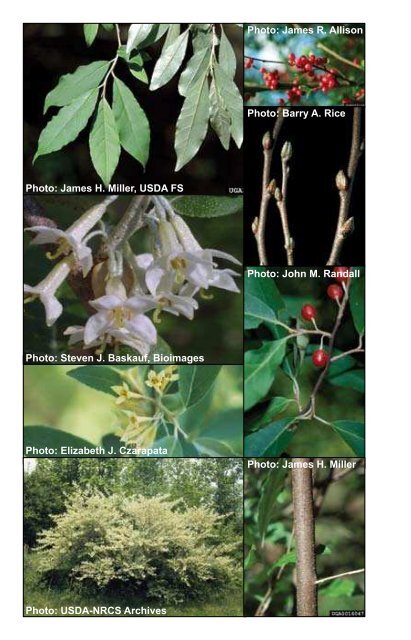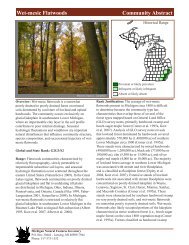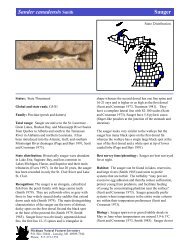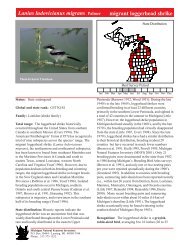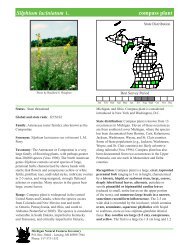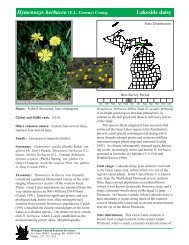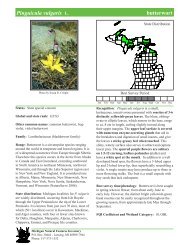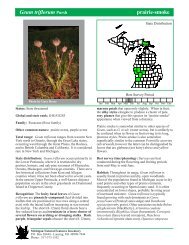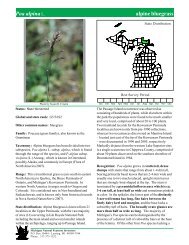Invasive Plants - Michigan Natural Features Inventory - Michigan ...
Invasive Plants - Michigan Natural Features Inventory - Michigan ...
Invasive Plants - Michigan Natural Features Inventory - Michigan ...
Create successful ePaper yourself
Turn your PDF publications into a flip-book with our unique Google optimized e-Paper software.
Photo: James R. Allison<br />
Autumn Olive<br />
Elaeagnus umbellata<br />
Photo: Barry A. Rice<br />
Habit: Deciduous shrub or small tree growing up to 6 m (20 ft) in<br />
height and 9 m (30 ft) wide.<br />
Leaves: Simple, alternate, oval, 5-10 cm (2-4 in) long; margins<br />
entire, wavy; gray-green above, silvery scaly below; early leaf out<br />
(mid-March).<br />
Stems/bark: Often thorny; silvery or golden brown, with brownish<br />
scales giving stems a speckled appearance.<br />
Flowers: Fragrant; tubular; 4 petals and stamens; cream to light<br />
Photo: James H. Miller, USDA FS<br />
yellow; in clusters of 1-8; bloom from April to June.<br />
Fruits/seeds: Drupe, 0.6 cm (0.25 in) in diameter; silvery with<br />
brown scales when immature, speckled red or yellow when mature;<br />
ripen September to October; begin to bear fruit at 3 to 5 years;<br />
each tree can produce 2-8 lbs. of seed per year; fruit eaten and seed<br />
Photo: John M. Randall<br />
dispersed by birds.<br />
Habitat: Moderately shade tolerant; occurs in a variety of soil<br />
types (pH range of 4.8-6.5), thrives on infertile soils because of<br />
nitrogen-fixing root nodules; found in open woods, forest edges,<br />
roadsides, fence rows, meadows, sand dunes, and other disturbed<br />
areas.<br />
Photo: Steven J. Baskauf, Bioimages<br />
Reproduction: By seed; also by root sprouting.<br />
Similar species: Related invasive Russian olive (E. angustifolia)<br />
has longer, narrower, leaves, silver above and below.<br />
Comments: Native to Asia. Invades disturbed areas, can out-compete<br />
native species; increases soil nitrogen levels which facilitates<br />
expansion of weedy and/or invasive species; had been widely rec-<br />
Photo: Elizabeth J. Czarapata<br />
ommended for conservation planting until invasive traits became<br />
Photo: James H. Miller<br />
apparent.<br />
Monitoring & rapid response: Monitor sunny open sites; autumn<br />
olive leafs out early in spring, retains leaves in fall, can be recognized<br />
year-round. Hand pull seedlings; focus on newest infestations<br />
and highest quality areas first; cutting, girdling and burning<br />
are ineffective unless used in conjunction with herbicide as they<br />
stimulate sprouting; basal bark/stem sprays effective in late spring;<br />
basal stem injection of herbicide on dormant plants provides excellent<br />
control with low concentrations of herbicide. This species is<br />
14 Photo: USDA-NRCS Archives<br />
difficult to control—research control options thoroughly.<br />
15


